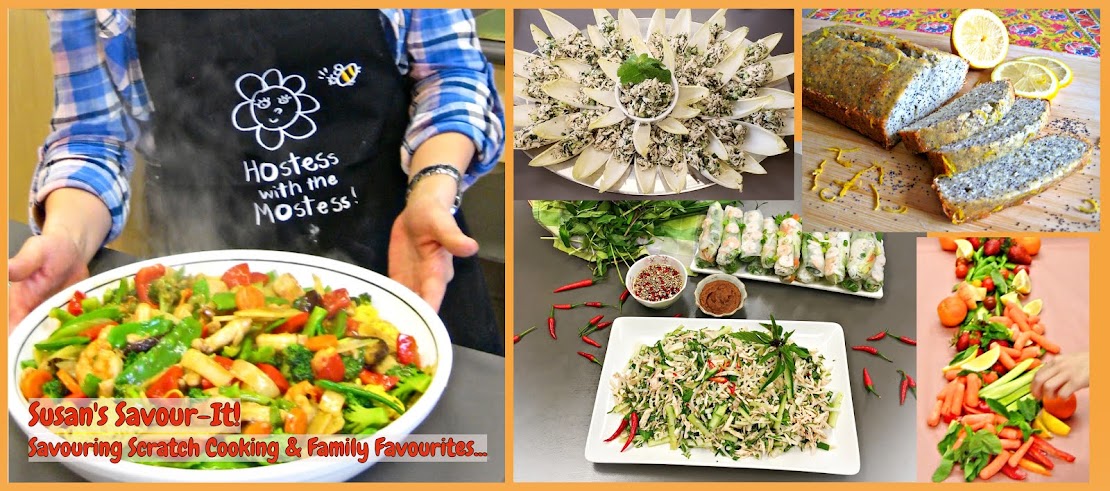I love to teach cooking, but when I get the opportunity I like to attend community cooking classes to keep my multi-cultural recipe repertoire fresh and expand my food skills. Last week, Korean Galleria Supermarket hosted their fourth free cooking class since summer. Started in July, they offered the public an hour class every two weeks. At this demo, thin slices of beef brisket were grilled and served warm with a fine sliced matchstick salad of kimchi, mixed peppers, cucumber and Asian pear. The sweet, tart and piquant vinaigrette of honey, lemon juice and Korean hot mustard perked my taste buds begging for more- the combo of flavours and crunchy textures over warm slightly fatty beef was a delight with every bite. Such a simple protein salad that uses superfood kimchi that can be served as part of a weeknight dinner, or as a showstopper entertainment platter. As a culinary instructor, I know I have succeeded when my participants replicate my dishes at home. This certainly was one I couldn't wait to make for my family. And I was right, hubby and kids were WoWed! Thank you (고맙습니다) Chef!
Chef arrived to Canada six months ago and have been cooking and teaching Korean cuisine for a long time. Here she explains her love of natural products such as a pure brew natural soy sauce. If you see the word Jin on Korean soy sauce, stay away because it is a blend.
Her gorgeous presentation of grilled beef rimming the plate and anchored with a mixed kimchi pepper slaw piled high in the centre.
This recipe makes extra vegetable salad you can serve on the side with your meal.
Grilled Beef Brisket and Kimchi Salad
Serves 6 to 8 (as a side)
1 lb. thinly sliced beef brisket (look for a good fat marbling)
1 Tbsp. soy sauce
1-1/2 Tbsp. mirin (you can substitute with 1-1/2 Tbsp. sake or cooking wine with 1 tsp. sugar)
1 each red, yellow and orange bell pepper, seeded and sliced thinly or into short matchsticks
1 Asian pear, cored and sliced thinly or into short matchsticks
1 cucumber, remove seeded core and sliced thinly or into short matchsticks
1 cup whole kimchi, (Chef suggests old fermented for extra acidity), washed, drained and sliced thinly
Salad Dressing:
1 Tbsp. lemon juice
1 Tbsp. sugar
1 Tbsp. Korean hot mustard (has a wasabi pungent kick to it)
1/2 Tbsp. honey
1 tsp. sea salt
2 Tbsp. water
1 Tbsp. oil (I use sunflower or grapeseed)
Chef prefers old fermented kimchi for its prominent acidic flavour and whole (poggi). I usually buy mat kimchi (which means sliced into pieces). The most popular style used in Korea is whole- it retains optimum flavour until you slice it to use. What a difference the flavour is compared to the regular style kimchi I buy- spicy but deeper and rich in tang. This fermented superfood is crunchy, tangy, spicy, and delicious.
Marinate the beef with the soy sauce and mirin mixed together.
Ladling over top with the beef slices in the tray like this works perfectly for sauce to well-distribute.
Chef prefers old fermented kimchi for its prominent acidic flavour and whole (poggi). I usually buy mat kimchi (which means sliced into pieces). The most popular style used in Korea is whole- it retains optimum flavour until you slice it to use. What a difference the flavour is compared to the regular style kimchi I buy- spicy but deeper and rich in tang. This fermented superfood is crunchy, tangy, spicy, and delicious.
Mix together the salad dressing ingredients, and set aside. If you don't have Korean hot mustard, substitute with wasabi or Dijon mustard. Chef suggests rinsing the whole kimchi to remove the spicy marinade and to bring out its acidic flavour and crunch. Squeeze excess liquid before slicing.
 |
| Removing the inner lining of bell peppers produces a cleaner and prettier presentation. |
Mix the peppers, kimchi, cucumber and Asian pear slices/matchsticks in a bowl. Drizzle in the salad dressing.
Grill or pan-fry the beef slices on both sides in a hot pan until caramelized and cooked, about one minute per side. Layer around the perimeter of your serving platter and pile the salad mixture in the centre.
Love that sweet, tangy and piquant vinaigrette slathering the beef!
This was my second cooking class at Galleria. More kimchi... at my first we made Paek Kimchi (white cabbage kimchi). Scientific studies indicate that kimchi is incredibly nutritious- a source of protein and vitamins A and B- and is low in calories. It is also a digestive, due to its fibrous texture and lactic acid content. The elaborate Korean way of pickling can be made simpler by preserving vegetables in heavily salted water without spices such as soy sauce, fish sauce, fermented red pepper or bean paste. One such pickle is White Cabbage Kimchi (Paek Kimchi) made the same as regular whole cabbage kimchi but without the hot red pepper powder, resulting in a pale colour with seasoning toned down providing a more delicate flavour. This kind of kimchi may be a good introduction for the curious to the vast world of kimchi.












Nice recipe, hope it tastes good. I have visited many restaurants in Mississauga area but never get a change to taste grilled beef brisket. I will try this at home. thanks.
ReplyDelete